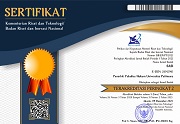Klaim Republik Rakyat China atas Zona Ekonomi Ekslusif Indonesia
 )
)
(1) Fakultas Hukum Universitas Pattimura, Ambon, Indonesia
 Corresponding Author
Corresponding Author
Abstract
Keywords
DOI
10.47268/sasi.v26i3.395
Published
2020-09-21
How To Cite
@article{SASI395,
author = {Efie Baadilla},
title = {Klaim Republik Rakyat China atas Zona Ekonomi Ekslusif Indonesia},
journal = {SASI},
volume = {26},
number = {3},
year = {2020},
keywords = {Claims; Zone Economic Exclusive; South China Sea},
abstract = {The South China Sea is a strategic marine area and contains both living and non-living natural resources. The purpose of this paper is to analyze China's claim to Indonesia's ZEE in the South China Sea, which is known to Indonesia as the North Natuna Sea. China's claim to the Nine dash line in the South China Sea has had an impact on Indonesia and several countries. The research method uses normative research with a statute approach and a conceptual approach. The results of his study show that the recent conflict between Indonesia and China in the South China Sea has brought about a new conflict between the two countries even though Indonesia has so far not considered a problem. In fact, the application of the nine dash line as Traditional fishing grounds was not known in UNCLOS 1982, but the concept known was Traditional fishing rights. Indonesia has sovereignty and sovereign rights over North Natuna waters based on UNCLOS, for this reason, Indonesia needs to continue to carry out exploitation and exploration activities, supervision and legal action to guarantee the sovereign rights of the State.},
issn = {2614-2961}, pages = {392--402} doi = {10.47268/sasi.v26i3.395},
url = {https://fhukum.unpatti.ac.id/jurnal/sasi/article/view/395}
}
[1] Gumilang, E; Utomo, H; Buntoro, K. (2018). "Dampak Aktivitas Militer Asing Di Zona Ekonomi Eksklusif Indonesia Terhadap Keamanan Maritim Indonesia", Jurnal Keamanan Maritim, 4(3): 21-42.
[2] Haiton, B. (2009), "The Modern Origins of Chinas South China Sea Claims: Maps, Misunderstandings, and the Maritime Goebody", Sage Journals.
[3] Monteiro, S. (2020), "Yurisdiksi Negara Pantai di Wilayah Delimitasi Maritim Zona Ekonomi Eksklusif yang Belum Ditetapkan Berdasarkan Ketentuan Hukum Laut Internasional (Study Di Timor Leste-Indonesia)", Jurnal Komunikasi Hukum, 6 (1): 303-334.
https://doi.org/10.23887/jkh.v6i1.23770
[4] Prakasa, S. U. W; Purwo, Al. (2019), "Analisis Historical Traditional Fishing Right Pada Zona Ekonomi Eksklusif Indonesia", Legality, 27 (1): 83-97.
https://doi.org/10.22219/jihl.v27i1.8960
[5] Rehatta, V. J. B. (2014), "Penyelesaian Sengketa Perikanan di Laut Lepas Menurut Hukum Internasional", SASI, 20 (1): 62-68.
[6] Santoso, T. I., (2020), "Aksi Agresivitas Cina Pada Zona Ekonomi Eksklusif Indonesia Laut Natuna Utara: Perspektif Tugas Pokok TNI". Jurnal Kajian Lemhannas RI, Edisi 41 (Maret): 35-46.
[7] Tampi, B. (2017), "Konflik Kepulauan Natuna Antara Indonesia dengan China (Suatu Kajian Yuridis)", Jurnal Hukum Unsrat, 23 (10): 1-16.
[8] Adololf, H. (1991). Aspek-Aspek Negara dalam Hukum Internasional, Jakarta: Rajawali.
[9] Koers, A. W, (1994). Konvensi Perserikatan Bangsas-Bangsa tentang Hukum Laut, Yokyakarta: Gajah Mada University Press.
[10] Kusumaatmaja, M. (2003), Hukum Laut Internasional, Bandung: Alumni.
[11] Mauna, B. (2000), Hukum Internasional: Pengertian, Peranan dan Fungsi dalam Era Dinamika Global, Bandung: Alumni.
[12] Subagyo, P. J. (2005). Hukum Laut Indonesia, Jakarta: Rineka Cipta.
[13] Sefriani, (2017). Hukum Internasional: Suatu Pengantar, Jakarta: Rajawali Pers.
[14] https//news.detik.com/berita/d4859575. Diakses 15 Januari 2020.
[15] https;www.medcom.id/ nota protes RI 7 Januari 2020.
[16] Juana, Hikmahanto, Ceramah pada Seminar Indonesian Society of International Law Lecturers, Samarinda Tanggal 3 Agustus 2019
[17] Juwana, H. "Dialog tvOne: Kapal Cina Masuk Laut Natuna", Tanggal 5 Januari 2020
[18] Juwana, H, "Press Release", 28 Januari 2020
[19] Juana, H, "Press Release", 30 Januari 2020
[20] Pernyataan pers Menteri Luar Negeri Indonesia, tvOne,26 Januari 2020.
| Dublin Core | PKP Metadata Items | Metadata for this Document | |
| 1. | Title | Title of document | Klaim Republik Rakyat China atas Zona Ekonomi Ekslusif Indonesia |
| 2. | Creator | Author's name, affiliation, country | Efie Baadilla; Fakultas Hukum Universitas Pattimura, Ambon; Indonesia |
| 3. | Subject | Discipline(s) | |
| 3. | Subject | Keyword(s) | Claims; Zone Economic Exclusive; South China Sea |
| 4. | Description | Abstract | The South China Sea is a strategic marine area and contains both living and non-living natural resources. The purpose of this paper is to analyze China's claim to Indonesia's ZEE in the South China Sea, which is known to Indonesia as the North Natuna Sea. China's claim to the Nine dash line in the South China Sea has had an impact on Indonesia and several countries. The research method uses normative research with a statute approach and a conceptual approach. The results of his study show that the recent conflict between Indonesia and China in the South China Sea has brought about a new conflict between the two countries even though Indonesia has so far not considered a problem. In fact, the application of the nine dash line as Traditional fishing grounds was not known in UNCLOS 1982, but the concept known was Traditional fishing rights. Indonesia has sovereignty and sovereign rights over North Natuna waters based on UNCLOS, for this reason, Indonesia needs to continue to carry out exploitation and exploration activities, supervision and legal action to guarantee the sovereign rights of the State. |
| 5. | Publisher | Organizing agency, location | Faculty of Law, Universitas Pattimura |
| 6. | Contributor | Sponsor(s) | |
| 7. | Date | (YYYY-MM-DD) | 2020-09-21 |
| 8. | Type | Status & genre | Peer-reviewed Article |
| 8. | Type | Type | |
| 9. | Format | File format | |
| 10. | Identifier | Uniform Resource Identifier | https://fhukum.unpatti.ac.id/jurnal/sasi/article/view/395 |
| 10. | Identifier | Digital Object Identifier | 10.47268/sasi.v26i3.395 |
| 11. | Source | Title; vol., no. (year) | SASI; Vol 26, No 3 (2020): Volume 26 Nomor 3, Juli - September 2020 |
| 12. | Language | English=en | en |
| 13. | Relation | Supp. Files | |
| 14. | Coverage | Geo-spatial location, chronological period, research sample (gender, age, etc.) | |
| 15. | Rights | Copyright and permissions | Copyright: Authors who publish their manuscripts in this Journal agree to the following conditions: 1. The copyright in each article belongs to the author, as well as the right to patent. 2. Authors can enter into separate, additional contractual arrangements for the non-exclusive distribution of the journal's published version of the work (e.g., post it to an institutional repository or publish it in a book), with an acknowledgment of its initial publication in this journal. 3. Authors are permitted and encouraged to post their work online (e.g., in institutional repositories or on their website) before and during the submission process, as it can lead to productive exchanges, as well as earlier and greater citation of published work. 4. Authors have the right to self-archiving of the article (Author Self-Archiving Policy)
License: The SASI Journal is disseminated based on the Creative Commons Attribution-NonCommercial 4.0 International license terms. This license allows anyone to copy and redistribute this material in any form or format, compose, modify, and make derivatives of this material for any purpose. You cannot use this material for commercial purposes. You must specify an appropriate name, include a link to the license, and certify that any changes have been made. You can do this in a way that is appropriate but does not imply that the licensor supports you or your use.
|
Copyright (c) 2020 Efie Baadilla

This work is licensed under a Creative Commons Attribution-NonCommercial 4.0 International License.

 : 4345 times
: 4345 times Download : 2861 times
Download : 2861 times
















